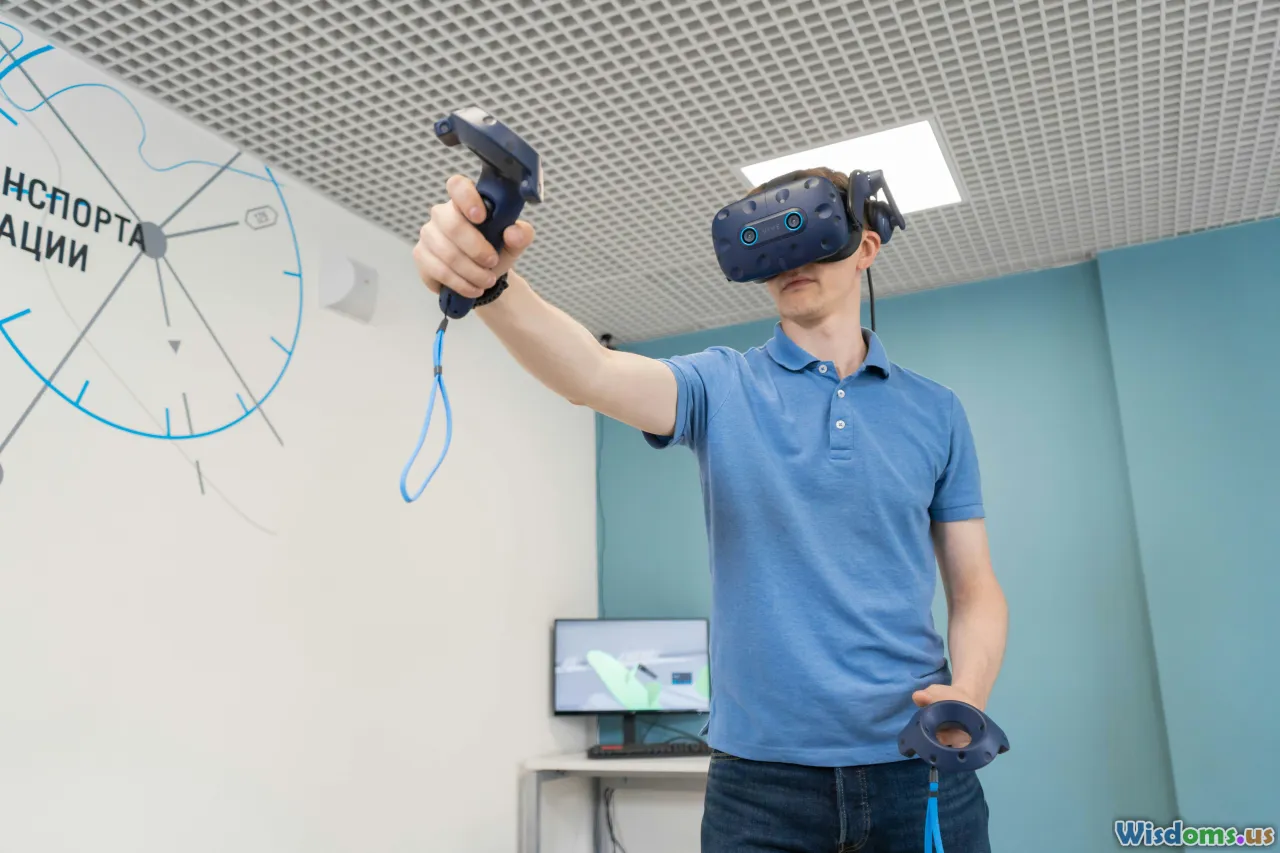
Learning Technologies Key to Continuous Professional Development
17 min read Explore how learning technologies are transforming continuous professional development across industries. (0 Reviews)
Learning Technologies Key to Continuous Professional Development
In a world where industries evolve rapidly and skills become outdated seemingly overnight, continuous professional development (CPD) has never been more critical. Organizations and professionals alike recognize that learning is not a one-off event but an ongoing journey. Emerging learning technologies sit at the heart of this transformation, equipping learners with just-in-time knowledge, tailored resources, and collaborative opportunities that keep them ahead in today's dynamic environments.
The Evolution of Professional Development Tools

For decades, professional development meant in-person workshops, bulky binders, and classroom lectures. While useful, these traditional forms often lacked flexibility and efficiency. The rise of digital tools and platforms has revolutionized how professionals approach learning.
Empowered by Learning Technologies (LTs), today’s employees can access on-demand courses, interactive webinars, smart simulations, and rich media libraries. According to the 2023 LinkedIn Workplace Learning Report, 89% of L&D professionals agree that proactively building employee skills will help organizations adapt to an ever-changing world.
Example in Action:
- Coursera for Business provides global enterprises with curated content from leading universities, supporting targeted skill development.
- SAP Litmos streamlines compliance training for remote teams in different countries, ensuring regulatory standards are met worldwide.
These platforms offer real-time analytics — managers instantly see learning engagement and effectiveness, leading to faster adjustments for better outcomes.
Adaptive Learning: Personalizing Growth Paths

One-size-fits-all training frequently leaves gaps. Adaptive learning technologies use machine learning and artificial intelligence (AI) to tailor learning experiences based on each individual's progress, strengths, and weaknesses. These smart systems dynamically adjust course content and pacing, maximizing efficiency and retention.
Imagine a project manager struggling with digital transformation concepts. With an adaptive platform like Sana Labs or Docebo, the system notices incorrect responses in certain areas and delivers customized modules until mastery is demonstrated. This approach dramatically increases knowledge retention and practical application.
Advantages of Adaptive Learning:
- Just-in-time support: Learners receive immediate interventions, speeding up their skill acquisition.
- Retention boosts: According to a study by the Bill & Melinda Gates Foundation, adaptive tech can improve learning outcomes by over 20% compared to traditional eLearning.
- Scalability: Organizations can simultaneously deliver personalized CPD to thousands of employees across locations and time zones.
Mobile Learning: Anytime, Anywhere Upskilling

The proliferation of smartphones has driven a surge in mobile learning (mLearning). Professionals can now access bite-sized lessons while commuting or waiting in line, transforming idle moments into valuable learning opportunities.
Companies like Duolingo for Business and EdApp design mobile-first content that’s highly interactive — think quick quizzes, videos, and scenario-based challenges. The rise of microlearning within app-based platforms means crucial information is delivered in small, digestible pieces, promoting sustained attention and engagement.
Actionable Tips for Mobile Learning Success:
- Push notifications: Schedule reminders to nudge users toward completing modules.
- Gamification: Enable leaderboards, badges, and progress tracking to spur motivation.
- Offline access: Ensure resources are downloadable for learning on-the-go without reliable internet.
Mobile learning is especially critical in sectors with deskless teams, like healthcare or retail, giving every worker the chance to upskill on their schedule.
Virtual Reality and Simulation: Bridging Theory with Practice

Certain skills are best refined through firsthand experience. Virtual reality (VR) and simulation-based technologies immerse learners in realistic scenarios, bridging the gap between theory and practice with low risk of real-world consequences.
Examples Include:
- Kognito provides healthcare and education professionals with powerful, scenario-based simulations for difficult conversations — from mental health interventions to crisis response.
- Strivr enables enterprises like Walmart and FedEx to scale immersive training for both customer service and logistics operations, reporting up to a 40% reduction in onboarding time.
VR allows professionals to repeat complex tasks, receive real-time feedback, and develop muscle memory. This is invaluable for surgeons, pilots, emergency responders, and engineers, where mistakes in the field carry serious risks.
Video-Based Learning: Engaging, Visual, and Effective

Video content remains one of the most engaging ways to deliver learning. Modern platforms pair high-quality video lessons with interactivity, quizzes, and social discussion features.
Standout Examples:
- LinkedIn Learning offers thousands of video courses with embedded quizzes, "Check your understanding" prompts, and direct connections to online discussion boards.
- Vyond and Camtasia empower subject-matter experts to create their own animated demos and explainer videos, streamlining bespoke content production organization-wide.
Key Benefits:
- Visual retention: According to the Social Science Research Network, 65% of people are visual learners. Video narration and graphics simplify abstract or technical topics.
- On-demand flexibility: Employees can pause, rewind, and replay as needed, fitting learning into their busy schedules.
Social and Collaborative Technologies: Learning from Each Other

Professional development is not all about solo study. Social learning platforms emphasize the value of collaboration — learners contribute to discussions, share best practices, and learn from peers in real time.
Platforms like Slack, Microsoft Teams, and Yammer now double as channels for ongoing CPD. Modern Learning Management Systems (LMS), such as Moodle Workplace or Cornerstone OnDemand, integrate forums, wikis, and cohort study groups, supporting active social engagement.
Best Practices for Social Learning:
- Mentorship programs: Match junior employees with experienced mentors.
- Peer feedback: Build activities that encourage group reflection and constructive critique.
- User-generated content: Empower colleagues to create case studies, tutorials, or solution guides — democratizing the creation and curation of resources.
This approach taps into the vast collective intelligence within organizations — nurturing both learning cultures and lasting professional networks.
Learning Analytics: Measuring Impact and Guiding Future Growth

It’s no longer enough just to launch a training program and hope for the best. Learning analytics gather rich data on how, when, and how well people learn. Leaders can thus make evidence-based decisions to optimize their CPD strategies.
For instance, major enterprises now:
- Use dashboards that highlight areas where staff struggle most, guiding investment in targeted support.
- Track how specific skills gained via eLearning correlate with business outcomes like customer satisfaction, retention, or innovation.
- Identify and reward power learners who drive positive team culture.
Global logistics company DHL leverages xAPI (Experience API) to connect digital learning activities with operational performance, improving efficiency and reducing error rates. Similarly, universities such as Arizona State University use analytics to boost graduation rates by supporting students at risk of falling behind.
Tips for Leveraging Learning Analytics:
- Define clear KPIs: Know what skills and outcomes you want to measure upfront.
- Automate reporting: Use LMS-integrated analytics to track and visualize progress.
- Close the loop: Regularly refine programs based on insights, demonstrating data-driven agility.
Microlearning and Nanolearning: Tiny Nuggets, Big Impact

In today’s fast-paced workplaces, lengthy courses are often impractical. Enter microlearning (modules less than 10 minutes) and nanolearning (sub-2-minute lessons). These formats tailor training to precious gaps of attention, driving strong uptake without overwhelming busy professionals.
Popular Microlearning Use Cases:
- Compliance Refresher Videos: Quick compliance updates help prevent mistakes and reduce liability.
- Sales Enablement Clips: Short product demos empower front-line staff with just-in-time knowledge.
Research from the Journal of Applied Psychology reports that microlearning improves information retention by up to 20% and significantly boosts completion rates compared to traditional methods.
Practical Strategies:
- Stacked micro-pathways: Combine short modules into comprehensive learning tracks.
- Frequent assessments: Insert mini-quizzes for memory reinforcement.
- Storytelling: Use narratives to make even shortest lessons sticky and memorable.
The Power of Open Educational Resources (OER)

Open Educational Resources (OERs) democratize access to high-quality learning materials by removing paywalls. Free MOOCs (Massive Open Online Courses) from MIT, Harvard, and public consortia have drastically widened the reach of professional education.
Platforms like edX, FutureLearn, and OpenLearn host vast free libraries — from leadership workshops to technical deep-dives in data science. OERs empower professionals to pursue personal learning goals on their own terms.
Best Practices for Integrating OERs:
- Curate carefully: Align open resources with internal competency frameworks.
- Blend learning modes: Mix OERs with proprietary training for broader skill coverage.
- Build learning communities: Encourage staff to share and review OERs, amplifying value for everyone.
Integrating Learning with Daily Workflows

Learning’s impact is greatest when seamlessly woven into daily routines. Embedded learning integrates micro-modules, digital resources, or context-sensitive tips directly within workplace applications such as CRM, email, or project management tools.
- Salesforce’s Trailhead delivers just-in-time training based on users’ real-time tasks.
- In-app "walkthroughs" using tools like WalkMe help users master software upgrades or compliance steps without ever leaving their workflow environment.
Strategies for Integration:
- Tie learning triggers to workflow events (e.g., instantly providing customer interaction tips before calls).
- Use browser extensions or process prompts during critical moments for timely learning interventions.
- Empower teams with "digital learning buddies" — chatbots that answer questions or recommend tailored resources throughout the day.
Such strategies drive higher engagement and close skills gaps faster, as employees see immediate relevance and benefit in their work context.
Navigating Challenges: Security, Accessibility, and Engagement

While learning technologies promise immense value, they also come with challenges:
- Data security: Safeguarding sensitive employee performance data is vital. Adhering to GDPR, employing robust encryption, and transparent privacy protocols are non-negotiable.
- Accessibility: Solutions must be inclusive — WCAG 2.1 compliance ensures participation for those with visual, auditory, or motor disabilities.
- Digital engagement: Overcoming "screen fatigue" or distraction involves user-centered design, compelling multimedia, and clear pathways for feedback and reflective learning.
Forward-thinking organizations continuously assess these factors, partnering with IT, HR, and accessibility advocates in CPD design.
Leadership Buy-In and a Culture of Lifelong Learning

Even the best technologies yield limited returns without supportive culture and leadership. Senior management’s endorsement of continuous, technology-supported learning sets the tone for the entire organization.
Case studies from Google, Unilever, and Deloitte show that when leadership publicly participates — sharing their own learning journeys and incentivizing skill mastery — uptake and enthusiasm cascade throughout their teams.
How Leaders Build Learning Cultures:
- Celebrate learning milestones at the team and company level.
- Incorporate CPD goals into performance reviews and talent pipelines.
- Allocate budgets for experimenting with emerging learning technologies.
Looking Ahead: The Future of Professional Development

The next frontier of CPD is being shaped by Artificial Intelligence, Augmented Reality, blockchain-based credentials, and advanced analytics. Professionals can soon expect:
- Hyper-personalized learning: AI-driven systems serving exactly what you need, when you need it.
- Real-time skill verification: Secure digital certificates and badges shared instantly to professional platforms.
- Immersive, inclusive experiences: Universal design in eLearning ensures every professional, regardless of background, has equitable access to growth.
The key to continuous professional development is not just adopting the latest tools — but strategically designing, blending, and championing learning technologies to drive real impact for both learners and the organizations they serve. By fostering a proactive, tech-enabled learning ecosystem, professionals and businesses can not only keep pace but leap confidently into the future.
Rate the Post
User Reviews
Popular Posts

















